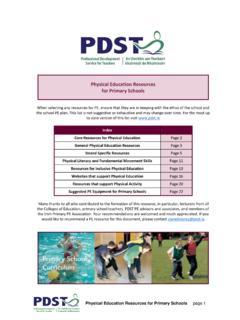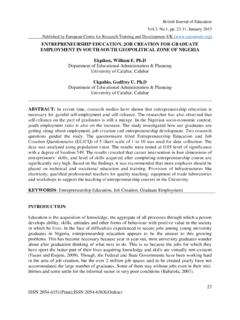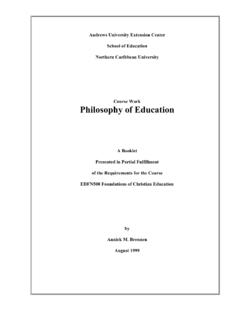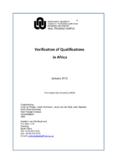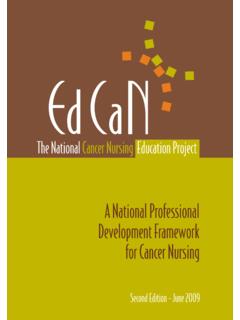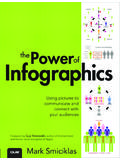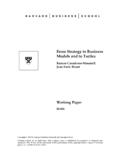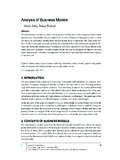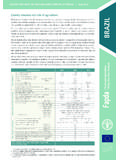Transcription of Junior Certificate Physical Education Syllabus Revised ...
1 ANROINNOIDEACHAIS AGUSEOLA OCHTAJUNIORCYCLEPHYSICAL EDUCATIONAims and Principles1. The general aim of Education is to contributetowards the development of all aspects of theindividual, including aesthetic, creative, critical,cultural, emotional, intellectual, moral, Physical ,political, social and spiritual development, forpersonal and family life, for working life, for liv-ing in community and for The Junior Certificate Programme is designed tomeet the needs of all students in second-leveleducation. Arising from this, every subject isoffered at two levels, ordinary and higher. In thecase of English, Irish and Mathematics a founda-tion level is also The Junior Certificate Programme aims to reinforce and further develop in the youngperson the knowledge, understanding, skillsand competencies acquired at primary level; extend and deepen the range and quality ofthe young person s educational experiencesin terms of knowledge, understanding, skillsand competencies; develop the young person s personal andsocial confidence, initiative and competencethrough a broad, well-balanced general edu-cation; prepare the young person for the require-ments of further programmes of study, ofemployment or of life outside full-time edu-cation; contribute to the moral and spiritual develop-ment of the young person and to develop atolerance and respect for the values andbeliefs of others.
2 Prepare the young person for the responsibili-ties of citizenship in the national context andin the context of the wider European andglobal The Junior Certificate Programme is based onthe following principles:Breadth and balanceAt this stage of their school careers, all studentsshould have a wide range of educational experi-ences. Particular attention must be given to rein-forcing and developing the skills of numeracy, lit-eracy and oracy. Particular emphasis should begiven to social and environmental Education , sci-ence and technology and modern languages. RelevanceCurriculum provision should address the imme-diate and prospective needs of the young per-son, in the context of the cultural, economic andsocial young person should be challenged toachieve the highest possible standards of excel-lence, with due regard to different aptitudes andabilities and to international Each Junior Certificate Syllabus is presented forimplementation within the general curriculumcontext outlined Junior CERTIFICATEJUNIORCYCLEPHYSICAL Education Junior CYCLE Physical Education Syllabus Introduction and Rationale.
3 2 Aims .. 4 Objectives .. 5 Syllabus Structure .. 6 Operational Structure .. 8 TopicsAdventure Activities .. 11 Aquatics .. 17 Athletics .. 23 Dance .. 29 Games .. 35 Gymnastics.. 41 Health-Related Activity .. 47 Assessment.. 53 Links.. 55 CONTENTS Junior CYCLE Physical Education Syllabus Physical Education applies a holistic approach to theconcept of Physical activity for young people. Itrecognises the Physical , mental, emotional, and socialdimensions of human movement, and emphasises thecontribution of Physical activity to the promotion ofindividual and group wellbeing. Learning in physicaleducation involves the acquisition of knowledge,concepts, skills, and attitudes central to physicaleducation, together with recognition of its potential forintegration with other curriculum general aim of Physical Education is to contributeto the preparation of the student for a life ofautonomous wellbeing.
4 This aim will be pursuedthrough the enhancement of the student s sense of self throughthe development of skilful and creativeperformance of practical activities development of the student s understanding of Physical activity and awareness of the links between Physical Education and othercurricular areas motivation of the student to choose a lifestyle thatis active, healthy and meaningful the personal enrichment of the student bydeveloping personal and social skills, andencouraging positive attitudes and values in her/hisinteraction with others. Physical Education syllabuses, at all levels, seek to buildon movement skills previously developed through thestudent s participation in Physical Education . These skillswill form the basis for further learning. The student willdevelop the capacity to create more complex movementpatterns in a variety of settings and modes.
5 Knowledgeand understanding of certain key concepts will berequired to enhance the student s experience. Thesyllabus will allow her/him to engage in an examinationof human movement from different perspectives. Forexample, the senior-cycle student will study thephysiological basis of human movement, the nature ofhuman performance or will examine human movementfrom an aesthetic perspective. She/he will be enabled todevelop a critical perspective on Physical activity, whileenjoying active and creative participation. In attemptingto promote a positive and constructive attitude tophysical activity, it is critical that the student learns to value Physical activity and demonstrates positiveattitudes towards participation. Participation in Physical Education should promote recognition ofindividual capacities, a positive attitude towardsparticipation and an appreciation of the benefits ofinteraction with others.
6 Students with Special Educational NeedsMany students have different personal resources fromthose whose profiles fit normative ages and to precisely define and delineate thiscategory of student is difficult. It can be said of suchstudents that, as a result of particular difficulties, theyexperience a range of barriers to learning. The barriersexperienced should be viewed as a social issue where theonus is on society, in this instance the school, to adaptto the needs of the individual for students is an essential prerequisite tolearning in Physical Education . Schools should facilitate,as far as possible, the inclusion of students withdisabilities in all Physical Education activities. Whileparticipation should be inclusive of all students, it isessential to present each student with activities not onlyfor participation but also for AND RATIONALE Junior CYCLE Physical Education Syllabus Physical Education syllabuses underline the principle ofinclusion.
7 They subscribe to the basic goal of meetingthe needs of all students, regardless of ability or level ofdevelopment. The accompanying Teacher Guidelines will offer advice and support on how inclusion can be participation and activity Physical Education plays a foundational role indeveloping pathways for Physical activity participation,on a day-to-day basis and in the future. Physicaleducation in the school should place as strong anemphasis as possible on opening up and reflecting onpractical opportunities for students. These opportunitiesshould be primarily based on the interests, talents, anddecisions of the student. The availability ofopportunities through the school and the widercommunity are important mediating factors. Theexistence of a clear, functioning policy on physicaleducation and Physical activity generally, and the role ofthe Physical Education teacher in implementing thepolicy, are also mediating implications of this approach are that physicaleducation will provide the student with the skills andinsights necessary to choose from.
8 Recreational involvement in Physical activity involvement in competitive sport the pursuit of individual goals in sport or dance,including high performance, if the desire andtalent is evident the pursuit of study in Physical Education andrelated areas spectating in an informed way by being aware ofthe principles, skills, and appropriate attitudes officiating or administrating as a volunteer or as acareer Junior Certificate RELIGIOUS Education Syllabus This Syllabus for Physical Education at Junior -cycle level is based on thegeneral rationale, aim and outcomes for Junior cycle Education outlined inthe opening section of this document. Further aims, objectives andlearning outcomes are presented at the start of the sections outlining thevarious areas of study within the Syllabus . The aims of Junior cycle Physical Education are to provide the opportunity for students to develop personally, socially,and physically through participation in Physical activities in a safe,challenging and enjoyable environment reinforce and further develop the Physical Education knowledge,understanding, skills, and competencies acquired at primary level prepare students for the requirements of further programmes ofstudy, of employment, or of life outside full-time Education provide an opportunity for students to critically reflect on physicalactivity through participation in a broad.
9 Well-balanced programme develop in students an ability to make informed judgements inrespect of Physical activity encourage an appreciation of Physical activity and of the benefits ofan active lifestyle promote positive attitudes towards participation in Physical activityand towards co-operation with others in that participation enable students to take responsibility for the organisation anddevelopment of their learning within the framework Junior CYCLE Physical Education Syllabus 5 Through their study of Junior cycle Physical Education students willdevelop: competence in the performance of a range of activities and theability to analyse these in the context of technical, physiological, andbiomechanical implications for the performer the ability to invent, compose, and choreograph Physical activity instructured, imaginative ways the ability to make decisions relating to Physical activity whileappreciating consequences in both tactical and moral contexts an understanding of the principles, rules, and purpose of differentcategories of activity, and the criteria for mastery of each an understanding of the psychological, sociological.
10 Aesthetic andbiological knowledge relevant to Physical Education an appreciation of the value of participation in selected physicalactivities as a lifelong endeavour an understanding of the principles of fairness and tolerance ininteraction with others the desire and the capacity to acquire a positive sense of Junior CYCLE Physical Education Syllabus 6 The Syllabus includes a number of areas of study representative of a range of practicalactivities, each of which has particular characteristics and contributes to the attainment ofthe overall aim of Physical Education . These areas of study are:1. Adventure activities2. Aquatics3. Athletics4. Dance5. Invasion games6. Net and fielding games7. Gymnastics8. Health-related activityThe areas of study are presented in greater detail on the following STRUCTURE Junior CYCLE Physical Education Syllabus ADVENTUREACTIVITIESO rienteeringTeam challengeCampcraftAQUATICSE ntryMovement in waterAqua fitnessWater safetyATHLETICSJ umpingRunningThrowing DANCEB asic actionsMovementqualityRelationshipsDance creationGAMESG ames makingAttacking playDefensive playGYMNASTICST hemesMovementvocabularyQualitative focusRelationships HEALTH-RELATEDACTIVITYA ctivity and the bodyFitness Training Lifelong activity7 Aquatics has a unique placein a balanced physicaleducation programme.
